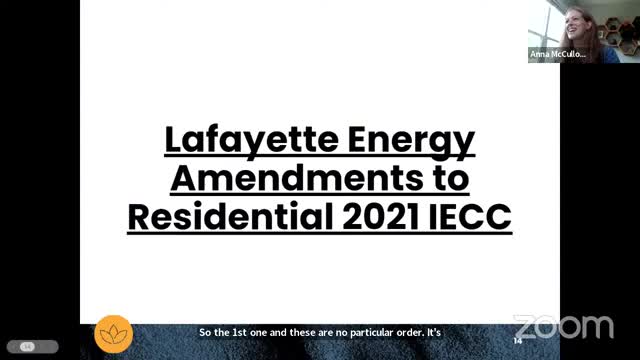Lafayette and Basalt adopt new energy efficiency codes for residential buildings
April 27, 2025 | Energy Office, State Agencies, Organizations, Executive, Colorado
This article was created by AI summarizing key points discussed. AI makes mistakes, so for full details and context, please refer to the video of the full meeting. Please report any errors so we can fix them. Report an error »

The Colorado Energy Office convened the Energy Code Board on April 27, 2025, to discuss amendments to the Low Energy and Carbon Code, focusing on residential and commercial building regulations. The meeting primarily addressed compliance pathways for the 2021 International Energy Conservation Code (IECC) and the integration of sustainable practices in building design.
The first topic of discussion centered on Lafayette's residential building code amendments. Three compliance pathways were outlined: the prescriptive pathway, the performance pathway, and the Energy Rating Index (ERI) pathway. For all-electric buildings, only one additional energy efficiency package is required, while mixed-fuel buildings must incorporate three packages, including one focused on envelope efficiency. The performance pathway mandates that all-electric buildings achieve 5% lower annual energy costs than the baseline, whereas mixed-fuel buildings must reach a 20% reduction. The ERI pathway sets targets of 55 for all-electric and 50 for mixed-fuel buildings, both requiring a 5% savings from these targets.
The meeting then shifted to Basalt's sustainable building regulations, which include both commercial and residential requirements. Notably, Basalt mandates additional air barrier testing for commercial buildings, with strict measures to address any leakage exceeding specified limits. The residential code offers three pathways for compliance, with homes under 2,000 square feet needing to demonstrate a 5% improvement in energy efficiency. For larger homes, a Home Energy Rating System (HERS) score of 40 is required, or 45 for all-electric homes. Additionally, new residential buildings must incorporate on-site renewable energy, with specific wattage requirements based on the building's size and energy use.
Commercial buildings in Basalt are required to have 40% of their roof area solar-ready and to offset 25% of their annual energy costs with on-site renewables, reduced to 15% for all-electric structures. The meeting also covered requirements for battery-ready, electric-ready, and EV-ready infrastructure in both residential and commercial buildings, ensuring future adaptability for renewable energy systems.
The discussions concluded with a focus on exterior energy use, where a renewable energy mitigation program will require buildings to offset energy consumption from outdoor features through on-site renewable sources. The meeting highlighted the ongoing commitment to enhancing energy efficiency and sustainability in Colorado's building practices, setting a framework for future developments in energy codes.
The first topic of discussion centered on Lafayette's residential building code amendments. Three compliance pathways were outlined: the prescriptive pathway, the performance pathway, and the Energy Rating Index (ERI) pathway. For all-electric buildings, only one additional energy efficiency package is required, while mixed-fuel buildings must incorporate three packages, including one focused on envelope efficiency. The performance pathway mandates that all-electric buildings achieve 5% lower annual energy costs than the baseline, whereas mixed-fuel buildings must reach a 20% reduction. The ERI pathway sets targets of 55 for all-electric and 50 for mixed-fuel buildings, both requiring a 5% savings from these targets.
The meeting then shifted to Basalt's sustainable building regulations, which include both commercial and residential requirements. Notably, Basalt mandates additional air barrier testing for commercial buildings, with strict measures to address any leakage exceeding specified limits. The residential code offers three pathways for compliance, with homes under 2,000 square feet needing to demonstrate a 5% improvement in energy efficiency. For larger homes, a Home Energy Rating System (HERS) score of 40 is required, or 45 for all-electric homes. Additionally, new residential buildings must incorporate on-site renewable energy, with specific wattage requirements based on the building's size and energy use.
Commercial buildings in Basalt are required to have 40% of their roof area solar-ready and to offset 25% of their annual energy costs with on-site renewables, reduced to 15% for all-electric structures. The meeting also covered requirements for battery-ready, electric-ready, and EV-ready infrastructure in both residential and commercial buildings, ensuring future adaptability for renewable energy systems.
The discussions concluded with a focus on exterior energy use, where a renewable energy mitigation program will require buildings to offset energy consumption from outdoor features through on-site renewable sources. The meeting highlighted the ongoing commitment to enhancing energy efficiency and sustainability in Colorado's building practices, setting a framework for future developments in energy codes.
View full meeting
This article is based on a recent meeting—watch the full video and explore the complete transcript for deeper insights into the discussion.
View full meeting
